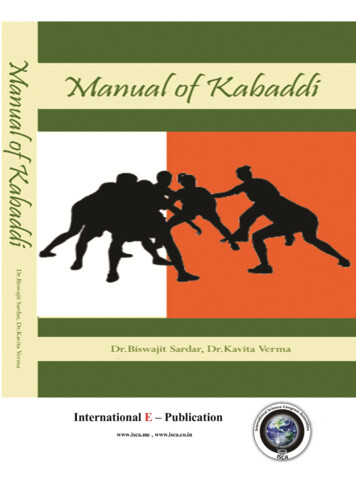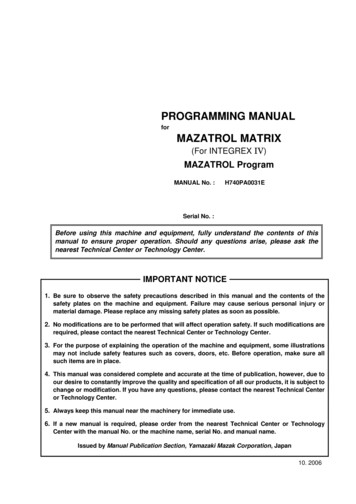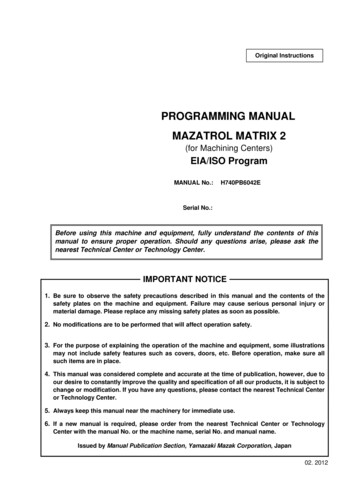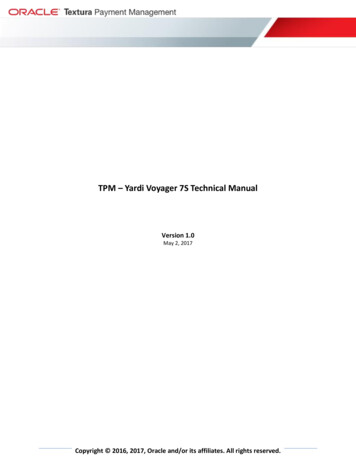
Transcription
Manual of KabaddiByDr. Biswajit SardarHead and Assitant Professor Department of PhysicalEducation, Dhiren Mahila P.G. College, Varanasi,U. P. India.Dr. Kavita VermaAssistant Director, University Sports Board,Banaras Hindu University, Varanasi, U.P., India.2014International E - Publicationwww.isca.me , www.isca.co.in
International E - Publication427, Palhar Nagar, RAPTC, VIP-Road, Indore-452005 (MP) INDIAPhone: 91-731-2616100, Mobile: 91-80570-83382E-mail: contact@isca.co.in , Website: www.isca.me , www.isca.co.in Copyright Reserved2014All rights reserved. No part of this publication may be reproduced, stored, ina retrieval system or transmitted, in any form or by any means, electronic,mechanical, photocopying, reordering or otherwise, without the priorpermission of the publisher.ISBN: 978-93-84648-26-8
International Science Congress Associationwww.isca.in , www.isca.co.in , www.isca.net.co , www.isca.net.inDedicatedDedicatedToMyLoving DaughterManual of Kabaddiiii
International Science Congress Associationwww.isca.in , www.isca.co.in , www.isca.net.co , st and foremost I offer my sincerest gratitude to myteachers of Lakshmibai National University of PhysicalEducation, Gwalior (M.P.) India, Who all are make mecompetent and capable to pursue this highly responsibletask. I would have been standing on the crossroads, hadit not been the constant encouragement and matureunderstanding of my teacher. Since their guidance wasalways persuasive rather than dictative, whatever faultsthat remain in the work are due to my discretion ut the course of writing this book, numerousindividuals from the physical education and sportscommunity have taken time out to help us out. My loveand gratitude for them can hardly be expressed inwords. I dedicate this thesis to my parents and mydaughter Gargi Sardar. Last but above all, I thank withheart and soul to the almighty who graced me withright thoughts and power to convent those thoughts intoaction.Manual of Kabaddiiv
International Science Congress Associationwww.isca.in , www.isca.co.in , www.isca.net.co , www.isca.net.inPrefaceTo have quality physical education at all levels it isessential to have a qualitative scientific literature / informationon aspects of physical education. This book is a step in thisdirection to design as both a text and resource in physicaleducation. This book gives a brief outline and provides a contextinformations to sports association’s, players and officials towardsthe Handball game trainning and cocahing. Whether you get yourHandball in with someone or alone, the single most significantway you can help yourself improve is to have a plan. Scheduleyour workouts into your day rather than let the day determinewhen you go to play. Without the premeditated effort of addingyour workouts to your calendar every week, fitting them in will be along shot on most days and a reality on very few.The pages of this book are filled with information on howto reap the most benefits of your time in the game by gettingprepared and having a plan.This book has been recognized into seven chapters. Eachchapter has been systematically organized and which willprovide precise information of Kabaddi game.Manual of Kabaddiv
International Science Congress Associationwww.isca.in , www.isca.co.in , www.isca.net.co , www.isca.net.inIn chapter I enhance the knowledge of kabaddi game cameto existence and how it developed and origin in india wide.Chapter II described The Rules and Regulation of Kabaddi,which makes the game most popular and attractive.Chapter III has been systematically organised in Technics OfKabaddi Game to understand Raid-Its Mechanism Structure ofRaid in kabaddi.Chapter IV is the most important section of the book,Fundamental skill in kabaddi. This can be the nTeacher,Physical Educations Institute and Colleges.Chapter V provides how to Guide to Role of Officials ForBest Performance of Kabaddi Players and TeamsChapter VI to described all Asian Federations of Kabaddi , whopresides over theWorld.Chapter VII to describe the Signals to Be Used By The Technical Officals,Awarded and List of Sports man.Manual of Kabaddivi
International Science Congress Associationwww.isca.in , www.isca.co.in , www.isca.net.co , www.isca.net.inTABLE OF CONTAINTChapter- nual of KabaddiOrigin Of KabaddiH History of Kabaddi In IndiaAsian Amateur Kabaddi FederationD Development of kabaddi in IndiaForms of KabaddiFamarGeminiSanjeevaniInter-national Kabaddi Federation (IKF)Chapter-IIRules of KabaddiRules of MatchesUnproductive Raid RuleTechnical OfficialsChapter-IIITechnics Of Kabaddi GameThe Raid-Its MechanismStructure of RaidCantEntrySetting and Path of ental skill in kabaddiAnkle HoldThigh HoldKnee HoldWaist or Trunk HoldWaist HoldWrist HoldBlockingAdvance skill in kabaddiSkill DrillsTechniques in KabaddiRaidFundamental raiding skillsPage. 27282829292930vii
International Science Congress Associationwww.isca.in , www.isca.co.in , www.isca.net.co , 6.16.26.36.46.57.17.27.2.1Manual of KabaddiFoot touchSudden leg thrustSquat leg thrustKicking in KabaddiFundamental Defence skillsChapter-VRole of Officials For Best Performance ofKabaddi Players And TeamsPhysical fitnessKnowledge of the rulesWarm UpCooling downConditioningWarm up activities & stretching exercisesThe Warm UpGeneral warm upStatic stretchingRoles of CoachingCoach/Athlete Training RolesCoaching skillsChapter-VIFederations of KabaddiIndiaPakistanBangladeshIranUnited KingdomChapter-VIISignals to Be Used By The TechnicalOfficalsArjuna AwardList Of PlayersABOUT 4444445464748viii
International Science Congress Associationwww.isca.in , www.isca.co.in , www.isca.net.co , www.isca.net.inChapter-IIntroduction1.1.Origin of KabaddiThe sport has a long history dating back to pre-historic times. It was probably invented toward off croup attacks by individuals and vice-versa. The game was very popular in the southernpart of Asia played in its different forms under different names. A dramatized version of thegreat Indian epic, the “Mahabharata” has made an analogy of the game to a tight situation facedby Abhimaneu, the heir of ' the Pandava kings when he is surrounded on all sides by the enemy.Buddhist literature speaks of the Gautam Buddha playing Kabaddi for recreation. History alsoreveals that princes of yore played Kabaddi to display their strength and win their bridesThe game, known as Hu-Tu-Tu in Western India, Ha-Do-Do in Eastern India &Bangladesh, Chedugudu in Southern India and Kaunbada in Northern India, has undergone a seachance through the ages. Modem Kabaddi is a synthesis of the game played in its various formsunder different names.Kabaddi is aptly known as the "GAME OF THE MASSES "due to its popularity,simplicity, easy to comprehend rules, and public appeal. The game calls for no sophisticatedequipment what so ever, which makes it a very popular sport in the developing countries. It isbasically an out door sport played on clay court, of late the game is being played on syntheticsurface indoors with great success. The duration of the game is 45 minutes for men & Juniorboys with a 5 minutes break in between for the teams to change sides. The duration of the gameis 35 minutes with a 5 miniutes break in between for women, girls, Sub-Junior boys and subjunior girls.Kabaddi is a combative team game, played on a rectangular court, either out-doors orindoors with seven players on the ground for each side. Each side takes alternate chances ofoffence and defense. The basic idea of the game is to score points by raiding into the opponentscourt and touching as many defense players as possible without getting caught on a single breath.During play, the players on the defensive side are called "Antis" while the player of the offenseis called the "Raider". Kabaddi is perhaps the only combative sport in which attack is anindividual attempt while defense is a group effort. The attack in Kabaddi is known as a 'Raid'.The antis touched by the raider during the attack are declared 'out' if they do not succeed incatching, the raider before he returns to home court. These players can resume play only whentheir side scores points against the opposite side during their raiding turn or if the remainingplayers succeed in catching the opponent’s raider. Yoga, the Indian science to control body andmind through meditation and self-control plays an integral part of Kabaddi. The raider has toenter the opponent's court chanting the word "Kabaddi" while holding his breath and has tocontinue to do so until he returns to his home court. This is known as 'Cant', which is closelyrelated to "Pranayama” of yoga. While Pranayama is about with holding breath in order toexercise internal organs, cant is the means to with hold breath with vigorous physical activity.This is perhaps one of the few sports to combine yoga with hectic physical activity.Manual of Kabaddi1
International Science Congress Associationwww.isca.in , www.isca.co.in , www.isca.net.co , www.isca.net.inThe game calls for agility, good lung capacity, muscular co-ordination, presence of mindand quick responses. For a single player to take on seven opponents is no mean task, requiresdare as well as an ability to concentrate and anticipate the opponent’s move.1.2. History of Kabaddi In IndiaKabaddi is a wrestling sport originating from very early Indian civilization. The wordKabaddi is derived from a Tamil word Kai-pidi (ைக-ப ), literally meaning "(let's) Hold Hands",which is indeed the crucial aspect of play. It is the national game of Bangladesh, and the state gameof Tamil Nadu, Punjab and Andhra Pradesh in India. The national kabaddi champion in India is thefamous Peter Singh Virk.Modern Kabaddi is a synthesis of the game which is played in various forms underdifferent names. Kabaddi received international exposure during the 1936 Berlin Olympics,demonstrated by Hanuman Vyayam Prasarak Mandal, Amaravati, Maharashtra. The game wasintroduced in the Indian Olympic Games at Calcutta in 1938. In 1950 the All India KabaddiFederation came into existence and compiled standard rules. The Amateur Kabaddi Federation ofIndia (AKFI) was founded in 1973. After formation of the Amateur Kabaddi Federation of India,the first men's nationals were held in Madras (re-named Chennai), while the women's were inCalcutta (renamed Kolkata) in 1955.The AKFI has given new shape to the rules and has the right tomodify them. The Asian Kabaddi Federation was founded under the chairmanship of Mr. JanardanSingh Gehlot.The first men's kabaddi nationals championship on Mat and indoor Stadium were held inPune and this championship Organized by Badami Haud Sangh in Pune. Kabaddi was introducedand popularized in Japan in 1979. The Asian Amateur Kabaddi Federation sent Prof. Sundar Ram ofIndia to tour Japan for two months to introduce the game.In 1979, a return test between Bangladesh and India was held at different places of Indiaincluding Mumbai, Hyderabad, and Punjab. The Asian Kabaddi Championship was arranged in1980 and India emerged as champion and Bangladesh runner-up. Bangladesh became runner-upagain in 1985 in the Asian Kabaddi Championship held in Jaipur, India. The other teams in thetournament were Nepal, Malaysia and Japan. The game was included for the first time in the AsianGames in Beijing in 1990. India, China, Japan, Malaysia, Sri Lanka, Pakistan and Bangladesh tookpart. India won the gold medal and has also won gold at the following six Asian Games inHiroshima in 1994, Bangkok in 1998, Busan in 2002, Doha in 2006 and Guangzhou in 2010. In the1998 Asian games the Indian Kabaddi team defeated Pakistan in a thrilling final match at Bangkok(Thailand). The chief coach of the team was former kabaddi player and coach Flt. Lt. S P Singh.Kabaddi is one of the most popular games which are played in villages. In this game twoteams occupy opposite halves of a field and take turns sending a raider into the other half, in orderto win points by tackling members of the opposing team, the raider then tries to return to his ownhalf, holding his breath and chanting the word Kabaddi during the whole raid. The raider must notcross the lobby unless he touches any of his opponents. If he does so then he will be declared as out.In the international team version of kabaddi, two teams of seven members each occupy oppositehalves of a field of 10 m 13 m in case of men and 8 m 12 m in case of women. Each has threeManual of Kabaddi2
International Science Congress Associationwww.isca.in , www.isca.co.in , www.isca.net.co , www.isca.net.insupplementary players held in reserve. The game is of two halves 20-minutes each and a fiveminute halftime break during which the teams exchange sides.Teams take turns sending a raider to the opposite team's half, where the goal of the raideris to touch the members of the opposite team before returning to the home half. The members whichare touched by the raider are out and temporarily sent off the field.The goal of the defenders is to stop the raider from returning to the home side beforetaking a breath.If any of the seven players cross the lobby without touching the raider he will bedeclared as out.The raider is sent off the field if: the raider takes a breath before returningthe raider crosses boundary linea part of the raider's body touches the ground outside the boundary (except during a strugglewith an opposing team member).Each time when a player is out, the opposing team earns a point. A team scores a bonus of twopoints, called a lona, if the entire opposing team is declared out. At the end of the game, the teamwith the most points wins.Matches are categorized based on age and weight. Six officials supervise a match: one referee, twoumpires, a scorer and two assistant.1.3. Asian Amateur Kabaddi FederationThe Asian Amateur Kabaddi Federation (AAKF) was formed in the year 1978, duringthe silver jubilee celebrations of National Kabaddi Championships in India, organized at Bhilai,Madhya Pradesh. The 1st Asian Kabaddi Championship was organize in Calcutta in the year1980 and was included as a demonstration game in the 9th Asian Games, New Delhi in the year1982. The game was included in the South Asian Federation (SAF) games from the year 1984 atDacca, Bangladesh. Kabaddi was included as a regular sports discipline in the 11th Beijing AsianGames 1990 and India won the lone Gold Medal in the Asian Games in Kabaddi. India is thereigning champion in the succeeding Asian Games held in Hiroshima 1994, Bangkok 1998, andBusan 2002 & recently at Doha 2006 and created history in Indian sports by winning fiveconsecutive Gold medals in the Asian Games so far. A goodwill tour was organized in the yearManual of Kabaddi3
International Science Congress Associationwww.isca.in , www.isca.co.in , www.isca.net.co , www.isca.net.in1981 in which, the Indian men & women teams visited Thailand, Japan and Malaysia to playexhibition Kabaddi matches. Federation Cup Kabaddi matches also commenced in the year 1981.For the first time in the history of Asian Games a separate indoor stadium was built forKabaddi competition and training in the 15th Asian Games held at Doha (Qatar) 2006. Thetraining/ warming up courts and main field of play was made up of puzzle mats of Korean make.The main field of play was equipped with a giant public screen, which displayed replays and therunning score. Two Tissot plasma scoreboards, info terminals for the presentation crew, theceremony crew and the media were provided.The second Asian Championship was hosted by India and was organized at Jaipur,Rajasthan. Malaysia and Japan participated for the first time in this Championship. In the XIAsian Games held in the year 1990 at Beijing, China, Kabaddi was included in the maindisciplines. This was a major landmark in the history of Kabaddi. India won the Gold Medal,which was a proud and unforgettable moment for Kabaddi lovers who had strived to bringKabaddi to the Asian platform. India has been the reigning champion in the succeeding AsianGames held in 1994 at Hiroshima, Japan and in the Asian Games held in 1998 at Bangkok inThailand.An International Women Kabaddi tournament commenced in the year 1995, called theNike Gold Cup, sponsored by NIKE, Japan. The III Asian Championship was hosted by SriLanka in the year 2000. For the first time, Sri-Lanka secured a silver medal, defeating Kabaddistalwarts Pakistan, in this Championship.Kabaddi will be introduced to the African countries as a demonstration sport in the AfroAsian Games, which is to be hosted by India in the year 2002. This is a feather in the cap forKabaddi lovers and has been made possible thanks to the efforts of Mr. J.S.Gehlot, President,Amateur Kabaddi Federation of India and the Indian Olympic Association.The 15th Asian Games Doha provided an excellent opportunity to showcase Kabaddi tothe Europeans and Australians who were in great numbers in organizing the Asian Games. Agood many spectators belonging to European countries, USA, Australia, Western Asia, and theMediterranean countries, who saw the Game for the first time, were very impressed with thesimple rules and the thrill of the sport and desired to introduce the sport in their countries. Thishas given Kabaddi very good and positive exposure for its future development in the continentsof Europe, USA, Australia and Africa.Kabaddi has been included as a major discipline in the 2nd Asian Indoor games to be heldat Macau from 25th October to 3rd November 2007 and in the Asian Beach Games being hostedby Indonesia in 2008, which are major landmarks in the history of the game.There has been a gradual but significant change in the trends of the game since the past50 years. What was once considered a game of brawn is not so now. The introduction of mats,shoes, new techniques & changes in rules has made the sport more interesting and advantageousto skilled players who are now able to defeat heavier players with better skills & techniques.Manual of Kabaddi4
International Science Congress Associationwww.isca.in , www.isca.co.in , www.isca.net.co , www.isca.net.in1.4. Development of kabaddi in IndiaKabaddi attained National status in the year 1918. Maharashtra was the pioneer state tobring the game to the National platform and give it further popularity. Standard rules andregulations were formulated in 1918 but were brought out in print in the year 1923 and in thisvery year, an All India Tournament was organized at Baroda with these rules. Kabaddi has notlooked back since then and numerous tournaments are organized all over the country throughoutthe year.The game got further recognition when the School Games Federation of India included itin the school games in the year 1962. This body has taken up the responsibility of organizingstate and national level competitions for school going children all over the country in varioussports on a regular basis, every year.Kabaddi was included in the curriculum of Regular Diploma courses in coachingconducted by the National Institute of Sports, the premier institute to develop sports in thecountry with effect from the year 1971. There after, qualified coaches in Kabaddi are beingproduced every ear. The neighboring countries, Nepal & Bangladesh also send I their coaches forthe diploma course in various disciplines including Kabaddi, regularly. These qualified coachesare equipped to train players at different levels in a systematic manner with sports science backup.The Amateur Kabaddi Federation of India, the new body, came into existence in the year1972. This body was formed with a view to popularize the game in the neighboring countries andorganize regular National level Men and Women tournaments. After the formation of this body,sub-junior and junior sections were included in Kabaddi national level tournaments, as a regularfeature.In the year 1974, the Indian men's team toured Bangladesh as part of the culturalexchange program to play five test matches in different parts of the country. The Bangladeshreturned the visit in the year 1979 and played five test matches in India.Kabaddi is a synthesis of the game played in various forms under different names.Kabaddi received international exposure during the 1936 Berlin Olympics, demonstrated byHanuman Vyayam Prasarak Mandal, Amaravati, Maharashtra. The game was introduced in theIndian Olympic Games at Calcutta in 1938. In 1950 the All India Kabaddi Federation came intoexistence and compiled standard rules. After formation of the Amateur Kabaddi Federation ofIndia, the first men's nationals were held in Madras (renamed Chennai), while the women's werein Calcutta (renamed Kolkata) in 1955.The AKFI has given new shape to the rules and has theright to modify them. The Asian Kabaddi Federation (AKF) was founded under the chairmanshipof Mr. Janardan Singh Gehlot.Kabaddi was introduced and popularised in Japan in 1979. The Asian Amateur KabaddiFederation sent Professor Sundar Ram of India to tour Japan for two months to introduce thegame.Manual of Kabaddi5
International Science Congress Associationwww.isca.in , www.isca.co.in , www.isca.net.co , www.isca.net.inIn 1979, a return test between Bangladesh and India was held at different places of Indiaincluding Mumbai, Hyderabad, and Punjab. The Asian Kabaddi Championship was arranged in1980 and India emerged as champion and Bangladesh runner-up. Bangladesh became runner-upagain in 1985 in the Asian Kabaddi Championship held in Jaipur, India. The other teams in thetournament were Nepal, Malaysia and Japan. The game was included for the first time in theAsian Games in Beijing in 1990. India, China, Japan, Malaysia, Sri Lanka, Pakistan andBangladesh took part. India won the gold medal and has also won gold at the following six AsianGames in Hiroshima in 1994, Bangkok in 1998, Busan in 2002, Doha in 2006 and Guangzhou in2010.An attempt to popularise kabaddi in Great Britain was carried out by Channel 4, whocommissioned a programme dedicated to the sport. The programme, Kabaddi in the early 1990s,however, failed to capture viewer attention despite fixtures such as West Bengal Police versusthe Punjab. Kabaddi was axed in 1992, but not before its presenter Krishnan Guru-Murthysuffered a collapsed lung while participating in the sport. Alt-rock band The Cooper TempleClause formed a kabbadi team in 2001 and were, at one stage, ranked seventh in the Britishdomestic standings.In the 1998 Asian games held at Bangkok (Thailand), the Indian Kabaddi team clinchedthe gold medal. The chief coach of the team was former kabaddi player and coach Flt. Lt. S PSingh.1.5. FORMS OF KABADDI1.5.1. FAMARAmar literally means invincible. This is a form of Kabaddi, which is played based -onpoints scored by both sides. The play field has no specific measurements and nine to elevenplayers constitute each of the teams. In this form of Kabaddi, there is no 'out' and .revival' systemor 'Iona' but time is the deciding factor. The main advantage of this form of the game is that tileplayers remain in the court throughout the match and are able to give their best performance.1.5.2. GEMINIThis form of Kabaddi is played with nine players on either side, in a play-field of nospecific measurements. The principle characteristic of this form of Kabaddi is that a player whois put out has to remain out until all his team members are put out. The team that is successful inputting out all the players of the opponent's side secures a point. This is akin to the presentsystem of 'Iona'. After all the players are put out, the team is revived and the game continues.The game continues until five or seven 'Iona' are secured. The game has no fixed time. The maindisadvantage of this form of Kabaddi is that the player Is not in position to give his bestperformance since he is likely to remain out for the better part of the match until a Iona is scored.1.5.3. SANJEEVANIManual of Kabaddi6
International Science Congress Associationwww.isca.in , www.isca.co.in , www.isca.net.co , www.isca.net.inThis form of Kabaddi is the closest to the present game. In this form of Kabaddi, playersare put out and revived and the game lasts for 40 minutes with a 5-minute break in between. Theteam consists of nine players on each side. The team that puts out all the players on theopponent's side scores four extra points for a 'Iona'. The winning team is the one that scores themaximum number of points at the end of 40 minutes. The play field is bigger in this form ofKabaddi and the 'cant' was different in various regions. Modem Kabaddi resembles this form ofKabaddi a great deal especially with regard to 'out & revival system' and 'Iona'. The present formof Kabaddi is a synthesis of all these forms of Kabaddi with a good number of changes in therules and regulations.1.6. Inter-national Kabaddi Federation (IKF)The Inter-national Kabaddi Federation (IKF) was formed during the 1st World Cup inKabaddi 2004 at Mumbai in India. The International Kabaddi Federation is the internationalgoverning body of Kabaddi Its membership comprises 31 national associations. The founderpresident is being Janardan Singh Gehlot from India. The other office bearers were: MohammedAli Pour (Iran), Khana Jawa (Japan), Veerawat (Thailand), Yoon Yeong Hak (South Korea),Ashok Das (United Kingdom); (Vice-president), Nisar Ahmed (Germany); (Secretary), R.M.Sunderashan (Malaysia); (Treasurer), Jaya Shetty (India); (CEO), Shankarrao Salvi (India);(Adviser). India won the First World Cup by beating Iran in the finals. The First Asian WomenChampionship was held at Hyderabad in 2005 and India won the Gold Medal. Women Kabaddiwas included for the first time in the South Asian Games held in Colombo, Sri Lanka in 2006.The second World Cup was held in India at Panvel in 2007 and India once again reignedsupreme.Manual of Kabaddi7
International Science Congress Associationwww.isca.in , www.isca.co.in , www.isca.net.co , www.isca.net.inChapter-II2.1. Rules of KabaddiThe game of Kabaddi shall be governed and played under the following rules:1) GroundGround shall be level and soft/Mat surface2) Play Field Measurementsa) Men and Junior Boys 13 X 10 Meters (as shown in the diagram).MEN Below 80 Kg WeightJunior BoysAge 20 years & below (last day of the year) and below 65 Kg weightb) Women and Junior Girls 12 X 8 Meters (as shown in the diagram).Women Below 70 Kg WeightJunior GirlsAge 20 years& below (last day of the year) and below 60 Kg Weight.c) Sub-Junior Boys and Girls 11 X 8 Meters (as shown in the diagram).Sub-Junior BoysAge 16 years & below (last day of the year) and below 50 Kg weight.Sub-Junior GirlsAge 16 years & below (last day of the year) and below 50 Kg weightManual of Kabaddi8
International Science Congress Associationwww.isca.in , www.isca.co.in , www.isca.net.co , www.isca.net.in3) Play Field The play field means that portion of the ground, which measures 13 meter by 8meter (ABCD) for Men & Junior Boys and 12 meters by 6 meter for Women, Junior Girls and11meter by 6 meter in case of Sub-Junior Boys & Sub-Junior Girls before struggle.4) Sitting Block The sitting block shall be at a distance of 2 meter from the end lines. It shall bea rectangle of 1 meter by 8 meter in case of Men & Junior Boys and 1 meter by 6 meter in caseof Women, Junior Girls, Sub-Junior Boys and Sub-Junior Girls.5) Boundary The lines on the four sides of the play field are known as the boundaries (AB, BC,CD and DA). All lines shall be of 3 to 5 cm width and form the part of the play field.Note: It is necessary to have 4-meter clear space outside the boundaries.6) Lobbies The strips on both the sides of the playfield measuring one meter in width are knownas the Lobbies. When the lobbies, as per rule 4 under ‘Rules of Play’ are included in theplayfield, the boundaries of the play-field are extended up to the four lines, which enclose theplay-field including the lobbies.7) Mid Line The line that divides the play field into two halves is known as the mid-line.8) CourtEach half of the play field divided by the mid line is known as the Court.9) Baulk Line Each of the lines in court parallel to the midline is known as baulk line. Thedistance of the baulk line from the mid line shall be 3.75 meter in case of Men and Junior Boysand 3 meter in case of Women, Junior Girls, Sub-Junior Boys and Girls.Manual of Kabaddi9
International Science Congress Associationwww.isca.in , www.isca.co.in , www.isca.net.co , www.isca.net.in10) Bonus Line The line parallel to Baulk line towards end line is known as Bonus line. Thedistance between Bonus line and Baulk line shall be 1 meterNote: Raider is said to have crossed the Bonus line when he comes into contact with theground between the End line and Bonus line. At the same time any part of his body should nothave contact with the ground between the mid line and Bonus line.11) CantThe repeated, without break; at a stretch and clear aloud sounding of the approved word“KABADDI”within the course of one respiration shall be called ‘Cant’.12) Raider One who enters into the court of the opponent with the cant is known as a‘RAIDER’. The raider must begin his cant before he touches the opponent’s court.13) Anti or Anti-Raider Every player in whose court the raid is being made shall be called Antior Anti Raider.14) Loosing the Cant To stop the repeated and clear aloud sounding of the word KABADDI’ ortake in a breath during cant by the raider is known as loosing t
which makes the game most popular and attractive . Chapter III has been systematically organised in Technics Of Kabaddi Game to understand Raid-Its Mechanism Structure of Raid in kabaddi. Chapter IV is the most important section of the book, Fundamental skill in kabaddi. This can be the well-built










